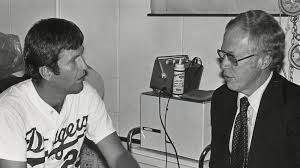History
Prior to the first ever Tommy John Surgery in 1974, a tear to the ulnar collateral ligament usually meant the end of a career. Johnny Podres, a former world series MVP in 1955 for the LA Dodgers, became very limited after suffering from an elbow injury in 1963. Joe Moeller is another Dodgers pitcher that had severely bad elbow problems that started to occur in the year 1962. Moeller made his major league debut at the age of 19 and had a bright and promising career ahead of him before he started having elbow problems. It is believed that both of these players could have rejuvenated their playing careers if Tommy John Surgery had been an option.24
The Procedure
 In 1974, Dr. Frank Jobe performed the first ever Ulnar Collateral Ligament Reconstruction (UCLR) on Tommy John, a pitcher for the LA Dodgers. In order to repair the elbow, Dr. Jobe first decided to use the palmaris tendon from the wrist to replace the damaged ligament. Then Dr. Jobe “drilled a couple of holes through the elbow bones and looped the harvested tendon through a couple of times, in figures of eight, locking it in with anchors.”24 After a few setbacks, the surgery proved to be a success and Tommy John went on to continue his very productive career.
In 1974, Dr. Frank Jobe performed the first ever Ulnar Collateral Ligament Reconstruction (UCLR) on Tommy John, a pitcher for the LA Dodgers. In order to repair the elbow, Dr. Jobe first decided to use the palmaris tendon from the wrist to replace the damaged ligament. Then Dr. Jobe “drilled a couple of holes through the elbow bones and looped the harvested tendon through a couple of times, in figures of eight, locking it in with anchors.”24 After a few setbacks, the surgery proved to be a success and Tommy John went on to continue his very productive career.
Rehabilitation
 Rehabilitation after a Tommy John Surgery is a very long and strenuous process. After an athlete has had the surgery rehab can last anywhere from 10-12 months. Like many other serious surgeries, the rehab process is broken down into different phases. In the first phase, the first two weeks following surgery, the athlete gently moves their wrist or shoulder to maintain motion. In the second phase, weeks 2 through 6, the athlete begins to do gentle shoulder, scapula, and wrist exercises as well as manual therapy by the physical therapist to help the athlete gain more motion. The athlete will usually wear a brace during this phase to protect the ligament from any damage. In the third phase which is 6-18 weeks after surgery, the athletes treatment program will mainly consist of shoulder and scapula exercise that will help strengthen the athlete once it is time to throw. Core stabilization is also a big part of this phase to help with posture dysfunction. The fourth phase begins 18-24 weeks after surgery and lasts 4-5 months. The athlete will continue to do shoulder and scapular strengthening exercises as well as shoulder and elbow stabilization exercises and plyometric exercises. The athlete will also begin doing 30 long tosses at 45 feet, then after two weeks he will progress to 50 throws of 60 feet. As the athlete continues to improve, he will eventually progress long toss to 100 total throws with 25 of those throws at distances as high as 210 feet. The therapist needs to make sure that they are teaching the athlete sound throwing mechanics in this phase. The final phase which is 8-10 months after surgery the athlete will begin to start throwing in practice and then will eventually throw in a real game in month 11 or 12 after surgery.25 Recovery from Tommy John Surgery is an arduous process, but the athlete will stronger and better than before if the process runs smoothly
Rehabilitation after a Tommy John Surgery is a very long and strenuous process. After an athlete has had the surgery rehab can last anywhere from 10-12 months. Like many other serious surgeries, the rehab process is broken down into different phases. In the first phase, the first two weeks following surgery, the athlete gently moves their wrist or shoulder to maintain motion. In the second phase, weeks 2 through 6, the athlete begins to do gentle shoulder, scapula, and wrist exercises as well as manual therapy by the physical therapist to help the athlete gain more motion. The athlete will usually wear a brace during this phase to protect the ligament from any damage. In the third phase which is 6-18 weeks after surgery, the athletes treatment program will mainly consist of shoulder and scapula exercise that will help strengthen the athlete once it is time to throw. Core stabilization is also a big part of this phase to help with posture dysfunction. The fourth phase begins 18-24 weeks after surgery and lasts 4-5 months. The athlete will continue to do shoulder and scapular strengthening exercises as well as shoulder and elbow stabilization exercises and plyometric exercises. The athlete will also begin doing 30 long tosses at 45 feet, then after two weeks he will progress to 50 throws of 60 feet. As the athlete continues to improve, he will eventually progress long toss to 100 total throws with 25 of those throws at distances as high as 210 feet. The therapist needs to make sure that they are teaching the athlete sound throwing mechanics in this phase. The final phase which is 8-10 months after surgery the athlete will begin to start throwing in practice and then will eventually throw in a real game in month 11 or 12 after surgery.25 Recovery from Tommy John Surgery is an arduous process, but the athlete will stronger and better than before if the process runs smoothly
References
24Tommy John Surgery Changed Baseball Forever. (n.d.). Retrieved April 04, 2016, from http://bleacherreport.com/articles/1672080-dr-frank-jobe-tommy-john-and-the-surgery-that-changed-baseball-forever#
25Rehabilitation following Tommy John Surgery. (n.d.). Retrieved April 04, 2016, from http://www.philly.com/philly/blogs/sportsdoc/Rehabilitation-following-Tommy-John-Surgery.html
No comments:
Post a Comment